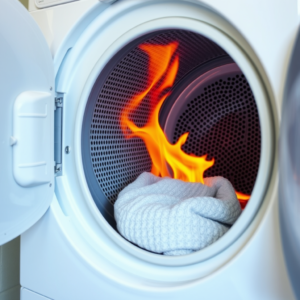It is every homeowner’s nightmare when a fire starts in the dryer. One moment, it is an ordinary task, and the next, something could change within a matter of minutes. But how does a dryer catch on fire? The NFPA states that around 14,000 dryer fires in U.S. homes were reported to which fire departments responded yearly from 2014 to 2018, causing millions of dollars’ worth of property damage, some loss of life, and hundreds of injuries. Adding to the urgency, recent reports from cities like Rochester have detailed fresh incidents, underscoring the need for action and awareness.
How Does a Dryer Catch on Fire?
The question of how a dryer catch on fire stems from a lack of maintenance, obstructed airflow, and sometimes, manufacturer design issues. Here’s an in-depth look at the major causes:
Accumulation of Lint
Lint is the chief cause of dryer fires, and fire departments from coast to coast agree. Jeff Shapiro of the Texas Fire Protection Association says that in addition to accumulating in the lint trap, lint can also collect within the vent pipes, as well as the exhaust hoses. This flammable material can ignite once it starts heating up in the dryer.
Clogged or Improperly Ventilated Dryer Ducts
The Rochester Fire Department has recently described a case in which heat and smoke from a dryer vent caused structural damage to a house. The cause? Airflow obstruction from accumulated lint in the vent. Licensed contractors state that to prevent this from happening again, the venting of appliances should be done professionally and ducts cleaned once or twice a year.
Overheating and Overloading
If the loading capacity of dryers is exceeded, it reduces the working efficiency and further risks overheating. If things go out of control with overheating, it can ignite the surrounding materials inside or spark to some nearby flammable surface.
Faulty Wiring
The second frequent source of dryer fires would be electrical problems, such as frayed wires, or the wearing out of components. Short circuits and sparks may develop due to any faults in the internal wiring of the machine or the connection of the outlet.
Flammable Items
Certain fabrics or items should not be subjected to dryers if you are talking about those with grease stains or any remnants of cleaning agents. They can catch fire more easily than you will expect.
Top Dryer Brands and Fire Safety Comparisons
Fire safety should definitely be high on your list of considerations in choosing a dryer. Some well-known dryer manufacturers have built a much better reputation than others for safety and reliability. Here’s a quick comparison of a few major brands:
LG
Advanced safety features such as flow-sense duct-blockage alerts are frequently touted for LG dryers. The alerts notify the user when vent clogs might be unsafe. LG ranks high on many lists for durability and customer satisfaction but is expensive.
GE Appliances
Overheating prevention systems and reliability are some of their great attributes. Some of the better safety features though user reviews mention occasional quality control issues that may arise from their prolonged usage.
Samsung
Samsung dryers maintain a good track record for energy efficiency and fire safety. Features like vent sensor technology help avoid fire risks caused by lint clogs, although some models have faced recalls in the past for wiring malfunctions.
Whirlpool
Whirlpool dryers, a trusted name in appliances, often include features for overheat detection and easy cleaning of lint traps. These dryers can keep the budget-conscious from compromising on safety.

Essential Tips to Keep Your Dryer Safe and Fire-Free
Now that you know how dryers catch fire, the next step is prevention. Incorporating these safety practices into your routine can significantly decrease the risk of a dryer fire:
Clean the Lint Trap After Every Use
A simple step is to clean the lint filter after each use, which is one of the most common ways a dryer fire can occur.
Inspect and Clean Dryer Vents
Every few months, make a habit of checking and cleaning the dryer vents. Visible lint buildup or decreased efficiency of your dryer would indicate that the vents need professional servicing.
Don’t Overload the Dryer
Stick to manufacturer guidelines regarding load capacity. Prevent the motor and heating unit from overheating by avoiding overloading the drum.
Use the Dryer for Appropriate Items Only
Never dry anything that bears the label flammable or heat-sensitive. Clothing with stains of oils, chemicals, or alcohol must first be properly washed before going into the drying process.
Schedule Regular Maintenance
Routine maintenance is critical to ensuring that the electrical and mechanical components in your dryer are in good working order.
Install a Smoke Detector in the Laundry Area
Install a smoke detector near your laundry room to provide early fire warnings in case of a malfunction.
These proactive measures not only safeguard your home but also preserve its value, especially if you’re looking to sell someday.
When it comes to selling a fire-damaged property keeping everything on the table is very important. Disclosing any past fire damage is legally required in most states and establishes trust with buyers. Additionally, it may reassure buyers to mention measures that were taken to avoid future occurrences, such as the installation of upgraded vents or smoke alarms.
Ignoring the risks of dryer fires can lead to costly repairs, health hazards, and legal issues during a sale. Proactive maintenance and understanding the implications of dryer fires ensure your home remains safe and marketable, even in challenging circumstances.
Previous